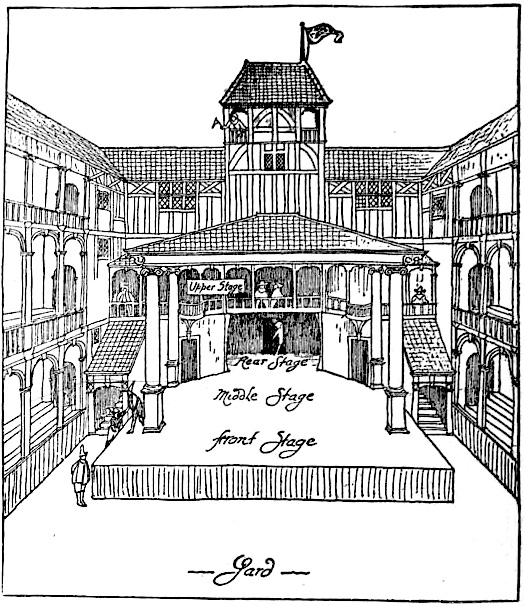Theatres,Actors and Acting in Shakespeare's time.
 Key points
Key points

During Elizabethan Era Playwrights,Actors and theatres were known by different names.
Playwrights-Poets
Actors-Players
Theatres-Playhouses
Section one:What are the theatres or playhouses of shakesperes time like and how were plays staged in them?
Timeline of theatres

The first purpose built theatre was the Red Lion in Whitechapel 1567.Later in 1567 it was replaced by a theatre in Shoreditch on one of the main roads north out of the city.The man behind the 'palava' was James Burbage.In 1599 Mr Burbage's sons Cuthbert and Richanrd used timbers as the frame to build the globe which is one of the several theatres which were on the South bank of the Thames which is still known as Bankside.In 1587 the Rose was built,The Swan in 1595,Then the Hope in 1614 and the second Globe aslo built in 1614 were all along the Bankside.North of these theatres were the Curtain built in 1577,the Fortune built in 1600 and the Red Bull.
What were Playhouses like?
The Swan
In 1595/1596 Francis Langley a successful Goldsmith built a theatre south of the thames.In 1596 a Dutch visitor;Johannes de Witt came to London and the Swan seems to be his favourite.In his diary he describe the Swan.'There are four amphitheaters in London of notable beauty...In them a different play is presented daily to the people.The two finest of these are situated to the south west beyond the Thames...Of all the theatres however the largest and most distinguished is that of which the sign is swan...since it has seating accommodation for three thousand persons,and is built of a mass of flint stones and supported by wooden columns painted in...excellent imitation of painted in...excellent imitation of marble...I have made a drawing of it.' From De Witt's diary we are able to tell how Playhouses were used and what they looked like.Below is a copy of De Wiit's Sketch which was made by his friend Arend Van Buchell in 1596.
How did the audience behave in a playhouse?

Below is a copy of what i wrote for my post about Shakespereares audience.This relates to how playhouses are like as it shows how the audience acted when in the playhouse.
In 1612, magistrates banned music at the end of plays at the Fortune, saying the crowd had caused ‘tumults and outrages’ with their dances. It gets worse because if audience members do not a play they make sure their opinions are heard through violence.At the Swan in 1602, the audience damaged the chairs, stools, curtains and walls. And, in 1629, a visiting French company were hissed and ‘pippin-pelted’ from the stage. This was because the company used women to play the female roles.
Construction of Theatres.
The Fortune
From an existing contract it shows that The Fortune is a square building which is very different from the others.It also had three storeys and 'Gentlemen's roomes' whic were special boxes for the higher paying audience members.Behind the stage was a tiring house and it had a tower which provided a space from which pieces of scenery and perhaps even people could be lowered.They called this the Heavens.
The Globe
Built to the engineering standards of 1599, the famous playhouse was a large circular structure, three stories high. A small straw hatched roof only partially covered the circular structure, giving it an appearance very much like a modern day football stadium where the center is uncovered.
In the center, pushed up against one interior side, extended the 5 feet high main stage. At the back of this stage facing the interior walls were two doors and a main entrance consisting of a central curtain. Behind this were changing rooms for the actors. To get back on stage, they would emerge from the arras or the two sidedoors at stage level. Above this stage was a balcony, flanked by two further balconies serving as playhouse boxes.
On the third level was a small house like structure supported by columns from the stage where announcements were made and the playhouse's flag would often fly, advertising plays currently being performed.
Again like a stadium, three rows of seating forming circular bands wrapped around the interior. These galleries at two pennies, cost more, but offered the comfort of seating. Those in the central uncovered courtyard had to stand through what could be a three hour performance, rain or shine.
"All the World’s a Stage".
Set in the middle of the playhouse, the playhouse's 44 wide by 26 foot long stage stood five foot off the ground, low enough to command a good view to courtyard watchers yet high enough to discourage the occasional stage jumper.
Two doors allowed actors backstage to enter, this being closed in by a central arras or hanging curtain. Above this was a balcony famously used in Romeo and Juliet when Romeo hears Juliet cry "Romeo, Romeo wherefore art thou Romeo". Similarly, the arras would have been pulled away in The Tempest to reveal the touchingly innocent scene of Miranda playing chess with Ferdinand and was also used for Hamlet’s stabbing of Polionius in Hamlet.
http://absoluteshakespeare.com/trivia/globe/globe.htm
Section Two:who were the actors of Shakespeares plays and how did the experience of being an actor differ from the experience today?

Who were the actors of Shakespeare's plays?
Boys VS Girls
During Shakepseres time the acting profession was only open for boys and Men.I'm glad that in today's society this profession is open to women too as i wouldn't be able to act plus these days that would be deemed as sexist.Women were able to act elsewhere is Europe but were not allowed to perform in public theatres in England till 1660.As females were not allowed to play female parts they used boys instead to play the roles. Occasionally men would play the older women.Men and boys definitely had it better then Girls and women.
Well known actors of the time

Richard Burbage
Edward Alleyn
Robert Armin
William Kemp
Nathan Field
http://www.shakespearesglobe.com/uploads/files/2014/01/actors.pdf
Shakespeare's Actors

During Elizabethan Era many of his plays were performed by the Lord Chamberlain's Men later named the King's Men acting company at the Globe and Blackfriars Theatres.The People who were part of Lord Chamberlain's men were Shakespeare, J & R Burbage, G Byran, John Hemminges, Augustine Phillips, Thomas Pope, Will Sly and Will Kemp.
The most famous of the group was Richard Burbage who inherited the smaller black friar's playhouse from his father.Burbage played challenging roles such as Hamlet, King Lear and Othello.
'Will Kemp who was a comic actor in their troupe, originally was one of the shareholder’s in the famous playhouse. He is thought to have played amongst other characters, that of Falstaff in the King Henry IV plays, certainly Peter, a servant to Juliet’s nurse in Romeo and Juliet and in all probability, Bottom, a weaver in A Midsummer Night’s dream.
Instead of staying with The Lord Chamberlain’s men, he left the other actors in 1599 to pick up his contribution to the new playhouse and instead Morris danced his way from London to Norwich.
Unhappy with this, he then danced across the Alps to take up acting at The Rose, one of the famous playhouse's competitors.
Arguably replacing Will Kemp in the more famous comic roles of Shakespeare’s plays was Robert Armin. Most famous for his role as the deceptively wise Fool in King Lear, Robert Armin also distinguished himself as the insightful clown Feste in Twelfth Night and as Touchstone in As You Like It.
John Hemminges, known to us in history as one of the actors (the other was Henry Condell) who compiled The First Folio, from which all records of Shakespeare’s plays are derived was with The Lord Chamberlain’s Men from, 1594, later becoming its manager.
Augustine Phillips was known as a musician and jig writer; a merry jig or dance always followed the conclusion of a play.
Thomas Pope joined in 1594, becoming a co-owner of the famous playhouse and playing comic roles like Will Kemp before him, thought to include that of Falstaff in the King Henry IV plays before passing away in 1604.
Will Sly joined The Lord Chamberlain’s men in 1594 along with Shakespeare at the same time. Along with becoming a co-owner in 1605, he also became a co-owner in the Blackfriar’s playhouse in 1608.'
http://absoluteshakespeare.com/trivia/globe/globe.htm

There were a great variety of characters to be played and some actors were renowned for playing a certain type of part. This led to some parts being specifically written to suit the actor playing them. For example, Shakespeare’s clown, Dogberry, in Much Ado About Nothing, was written for William Kemp because he was very good at physical comedy. Similarly, the fool in King Lear was written for the actor Robert Armin, who focused on witty language rather than slapstick.
http://www.shakespearesglobe.com/uploads/files/2014/01/actors.pdf
How did the experience of being an actor differ from today?

Experience of being a actor then is different from now as firstly they there are male and female actors and usually if a man is playing a female it's for comedy like in a panto.Secondly During Elizabethan times the actor had to exaggerate their role and shout their lines so people could hear where as now you don't over play your art or shout your lines as we have buildings which have good acoustics.
No comments:
Post a Comment